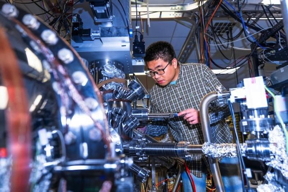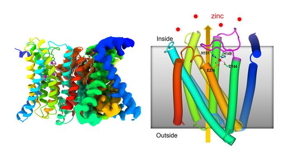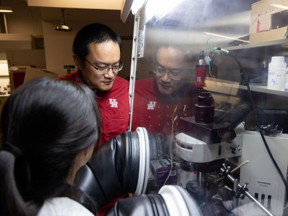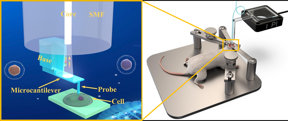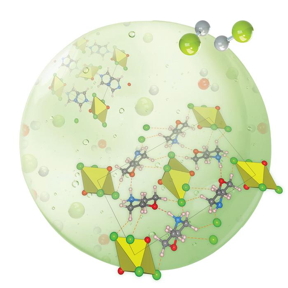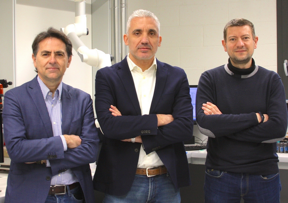Home > Press > Two-dimensional bimetallic selenium-containing metal-organic frameworks and their calcinated derivatives as electrocatalysts for overall water splitting
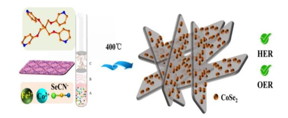 |
| By utilizing the 2D-MOF as self-sacrificial template selenium-containing materials had been produced via simple method, which exhibits the efficient activity for overall water splitting
CREDIT |
Abstract:
Transition metal selenides have been considered to be a good choice for electrocatalytic water splitting. In addition, Metal-organic frameworks (MOFs) have been used to make catalysts with good electrocatalytic capabilities. Traditionally, the MOF-derived selenides are produced via the self-sacrificing MOF template methods. However, this strategy is high-energy consuming, and it is difficult to precisely control the structure and component homogeneity of the product during pyrolysis.
Two-dimensional bimetallic selenium-containing metal-organic frameworks and their calcinated derivatives as electrocatalysts for overall water splitting
Beijing, China | Posted on March 8th, 2024
A research group of Wang-ting Lu, Fan Yu, and Yun Zheng from Jianghan University and Fuzhou University used two-dimensional (2D) layered metal-organic frameworks (MOFs) as self-sacrificial templates to create high-efficiency Selenium (Se)-containing electrocatalysts for overall water splitting. They adopted two strategies to introduce Se element into the Co–Fe MOF, one being the etching of as-prepared MOF by SeO2 solution and the other, the replacing of SCN− with SeCN− as the construction unit. The electrochemical activity of Se-containing electrocatalysts for catalyzing the hydrogen evolution reaction (HER) and oxygen evolution reaction (OER) is evaluated and further discussed.
It is found that both two Se introducing approaches can obviously improve the HER performance during overall water splitting. The high electrochemical performance may be resulted from the unique 2D hierarchical porous structure and strong synergistic effect between different components in the material.
This work reveals that the rational design of layered MOFs with S- or Se-containing linkers as water splitting catalysts is a feasible option for the development of economical and low-energy-consuming electrocatalysts. Meanwhile, it provides an innovative approach for the synthesis of MOF-based metallic selenides.
####
For more information, please click here
Contacts:
Rong Xie
Higher Education Press
Office: 105-855-6485
Copyright © Higher Education Press
If you have a comment, please Contact us.
Issuers of news releases, not 7th Wave, Inc. or Nanotechnology Now, are solely responsible for the accuracy of the content.
| Related Links |
| Related News Press |
Chemistry
![]()
What heat can tell us about battery chemistry: using the Peltier effect to study lithium-ion cells March 8th, 2024
News and information
![]()
Researchers develop artificial building blocks of life March 8th, 2024
Possible Futures
![]()
Nanoscale CL thermometry with lanthanide-doped heavy-metal oxide in TEM March 8th, 2024
![]()
Optically trapped quantum droplets of light can bind together to form macroscopic complexes March 8th, 2024
Discoveries
![]()
What heat can tell us about battery chemistry: using the Peltier effect to study lithium-ion cells March 8th, 2024
![]()
Researchers’ approach may protect quantum computers from attacks March 8th, 2024
![]()
High-tech ‘paint’ could spare patients repeated surgeries March 8th, 2024
![]()
Nanoscale CL thermometry with lanthanide-doped heavy-metal oxide in TEM March 8th, 2024
Announcements
![]()
What heat can tell us about battery chemistry: using the Peltier effect to study lithium-ion cells March 8th, 2024
![]()
Nanoscale CL thermometry with lanthanide-doped heavy-metal oxide in TEM March 8th, 2024
Water
![]()
Taking salt out of the water equation October 7th, 2022
![]()
UBCO researchers change the game when it comes to activity tracking: Flexible, highly sensitive motion device created by extrusion printing June 17th, 2022
Battery Technology/Capacitors/Generators/Piezoelectrics/Thermoelectrics/Energy storage
![]()
What heat can tell us about battery chemistry: using the Peltier effect to study lithium-ion cells March 8th, 2024
![]()
A battery’s hopping ions remember where they’ve been: Seen in atomic detail, the seemingly smooth flow of ions through a battery’s electrolyte is surprisingly complicated February 16th, 2024
- SEO Powered Content & PR Distribution. Get Amplified Today.
- PlatoData.Network Vertical Generative Ai. Empower Yourself. Access Here.
- PlatoAiStream. Web3 Intelligence. Knowledge Amplified. Access Here.
- PlatoESG. Carbon, CleanTech, Energy, Environment, Solar, Waste Management. Access Here.
- PlatoHealth. Biotech and Clinical Trials Intelligence. Access Here.
- Source: http://www.nanotech-now.com/news.cgi?story_id=57461
- :is
- :not
- :where
- $UP
- 10
- 16th
- 17th
- 27
- 2D
- 3rd
- 4
- 5
- 7
- 7th
- 8th
- 9th
- a
- About
- access
- accuracy
- Achieve
- activity
- addition
- adopted
- advanced
- against
- an
- and
- approach
- approaches
- ARE
- artificial
- AS
- batteries
- battery
- BE
- been
- Beijing
- being
- Better
- between
- bind
- Blocks
- Bonds
- both
- Brazilian
- Building
- by
- CAN
- capabilities
- capture
- catalysts
- catalyzing
- Center
- CGI
- change
- chemical
- chemistry
- China
- choice
- click
- COM
- comes
- comment
- complex
- component
- components
- computational
- computers
- conductor
- conducts
- considered
- construction
- consuming
- content
- control
- could
- create
- created
- credit
- December
- del
- Derivatives
- Design
- designs
- detail
- develop
- developed
- Development
- device
- Devices
- different
- difficult
- direction
- discovered
- Discovers
- discussed
- during
- Education
- effect
- Effective
- efficient
- electrolyte
- electrolytes
- electrons
- element
- end
- Engine
- Ether (ETH)
- evaluated
- evolution
- exhibits
- fan
- feasible
- February
- flexible
- flow
- For
- form
- formulation
- found
- frameworks
- from
- further
- game
- generate
- gif
- gives
- good
- Group
- had
- Have
- Health
- her
- High
- higher
- Higher education
- highly
- However
- http
- HTTPS
- hydrogen
- if
- improve
- improvements
- in
- Inc.
- industry
- inflammation
- information
- innovative
- Institute
- into
- introduce
- introducing
- involving
- IT
- ITS
- July
- june
- layered
- Leads
- li
- light
- links
- lithium
- make
- many
- March
- material
- materials
- May..
- Meanwhile
- mechanism
- metal
- method
- methods
- million
- monumental
- more
- motion
- nanotechnology
- neighboring
- net
- New
- news
- novel
- November
- now
- october
- of
- on
- ONE
- optimal
- Option
- or
- Other
- out
- overall
- Oxygen
- paint
- pandemic
- patients
- performance
- PHP
- plato
- Plato Data Intelligence
- PlatoData
- please
- Post
- posted
- precisely
- press
- Press Release
- Produced
- Product
- properties
- protect
- protection
- proved
- provides
- Quantum
- quantum computers
- rapidly
- Rational
- reaction
- receives
- release
- Releases
- remember
- repeated
- research
- research group
- researchers
- responsible
- resulted
- return
- Reveals
- revolutionize
- salt
- Save
- scientists
- Search
- seemingly
- seen
- sensitive
- Share
- shed
- Simple
- smooth
- Soft
- solely
- solid
- solution
- Soon
- start
- strange
- strategies
- Strategy
- streamlines
- strong
- structure
- Study
- submit
- such
- Surface
- surprisingly
- sustainable
- synergistic
- synthesis
- system
- team
- tell
- template
- templates
- tested
- tests
- that
- The
- their
- they
- this
- Through
- to
- together
- tool
- Tracking
- traditionally
- trapped
- treatment
- two
- unique
- unit
- Universal
- university
- unlocks
- us
- used
- using
- Utilizing
- via
- vital
- Water
- Wave
- web
- when
- which
- with
- Work
- Yahoo
- you
- zephyrnet










